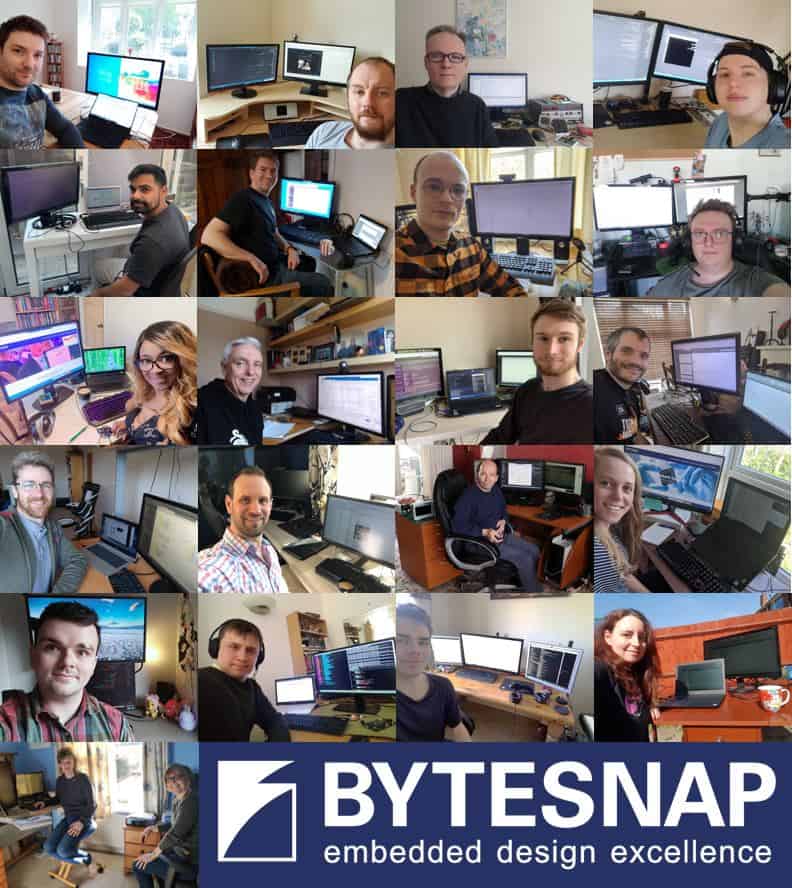COVID 19-Proof Your Electronics Product Design Projects for Working From Home
It’s fair to say that – due to the COVID-19 pandemic – the world of work will never quite be the same again.
We’ve been working from home, in lockdown, for a few weeks now. To date, a number of problems and solutions have cropped up, some specific to technical teams.
There are plenty of resources to do with video conferencing solutions, time management etc. But we thought we would cover other issues more unique to the electronics development sector.
So as an electronics design house, how can you rise to the trials of staying at home and successfully push through projects in what could become a hostile economic climate for the next few months?
Here are the challenges as a team of remote workers, we’ve overcome so far…

Framework for Working From Home
There are several factors to check – CAD tool licenses, ESD protection, test equipment access to name a few. These will ensure your electronics product design staff will be able to deliver to customers what they need, when they need it.
Electronics design resource for home working
You need to be confident that your engineers are able to continue working on your project, in their own homes. Questions to ask are ones such as:
- What access do they have to tools necessary for the job? E.g.:
- soldering equipment
- spectrum analysers, Multimeters, PSUs, oscilloscopes
- test equipment
- How suitable is their working environment? Is it clutter-free?
Electronics and firmware engineers typically need more space than average workers. They often plug target hardware and test equipment into their desktop or laptop PCs. Some of our design consultants have repurposed rooms to create the required space for flexible working.
Also consider ergonomics – this is a long-term situation. A few staff have taken desk chairs home, rather than working whilst sat in fixed chairs.
Other areas to consider for home working
- How are engineers able to maintain electrical safety? Protection of others in the household of the electronics design engineer is equally important. This is particularly crucial when working with any equipment that is mains powered, generates high voltages or heat. In general, we would recommend not leaving prototype devices powered and unattended in a domestic environment. Though, admittedly, this sometimes cannot be helped during testing. However, bear in mind that even the most benign looking board can be a fire hazard if not treated correctly.
- Privacy and security of data must also be addressed [1]. Many projects involve working with sensitive data. Take care of remote access in the same way you would in the work place.
- Are products being worked on being protected? In particular, is ESD protection in place? At ByteSnap, we have provided earthing mats for the remote teams of engineers working on unenclosed PCBs at home.
- Do staff have access to a “bare-bones” shared office? If they’re still able to access their regular place of work, maintaining social distancing, this can be very helpful in sustaining project momentum.
You would expect these visits to be limited to team members who absolutely need to use the office workplace. Typically, those people will be dealing with either large pieces of equipment or hardware-related issues requiring test gear.
However, even here, with a bit of imagination, the need to visit the office can be lessened. For instance, on one project our engineers developed a work-around by using Arduinos to cycle power to boards and webcams to monitor the status of LEDs and displays on the PCBs. This has reduced significantly the number of people needing to use the barebones office.

Software development resources, IT infrastructure
You must have solid IT infrastructure in place. A good quality, secure VPN, allows employees to work remotely on corporate networks. Take IT equipment home that is easily portable to reduce VPN loading and improve ease of use compared with VNC and remote desktop. Be sure you have adequate server bandwidth for remote desktops and that your engineers are working with full (preferably at least 2) monitors, rather than just huddled over laptops.
Think about how your software engineers will liaise and interact with customers.
For example, some projects might have a screen that must be interacted with via a mouse or touch inputs. This can be problematic when working from home as the user can’t access the screen of the embedded device they are working on.
Thankfully, there are workarounds which allow the user to control a screen remotely. Windows Remote Desktop or Virtual Network Computing (VNC) are two systems. Both systems compose of two key components: a server which shares the screen of the device, and a viewer which displays the screen received form the server at the remote end. Windows Remote Desktop uses built in hardware acceleration on PCs. It is also the quicker of the two when available in a Windows environment. VNC is more portable and usable on Linux desktop and embedded boards alike.
There are, of course, multiple software tools out there that offer this service; some take this a step further and allow the user to control the remote device from any modern browser, including mobile devices.
Though portable, mobile devices may be required to be in close proximity of the embedded devices in the office. There are free tools such as Genymobile (https://github.com/Genymobile/scrcpy) that allow you to view and control a connected Android device.
Again, both your project engineers and those from your design partners, need to be well-versed in your development tools, platforms and IDEs.
Design tool licenses
Remember to check your license servers too.
You might need to switch from node-locked licence to a floating one. If you’re sharing software that previously you could do with a node-locked device (node locked is where the license of a CAD tool, compiler etc. restricts use to a single PC via a MAC address or plug-in dongle), that would normally be fine in a shared office.
But with your electronics design engineers now all working remotely, you will probably need to check your licence terms and see if you can upgrade to a floating license that can be accessed across a VPN.
Talk to your licence suppliers; some may offer concessions such as free or reduced rate licence upgrades, due to the lockdown. For example, OrCAD are currently providing a 30 day free license to users to help them work from home (see https://www.orcad.com/orcad-work-from-home-program).
Supply Chain
Given the disruption to various industry supply chains, globally, you may need to build extra time into your project. This allows for sourcing and shipping of parts/modules/components.
Schedule kitting of parts early on in a design process, as parts are on extended lead times. This even includes for stock items. Plans will need reworking to take this into account. Where we would normally kit each build of prototypes prior to the revision, we have switched to kitting later builds as well as the first revision, once the BOM is ready. The small wastage from changes to the design after the first revision is easily offset by the potential saving in time waiting for component deliveries.
Liaise with your suppliers about how they will get any necessary parts from you for your development. Will they be delivered to your barebones office? Or direct to an engineer’s home? Get these details sorted as soon as you can – vital components going astray will only add costly delays to your projects.
Communications when Working From Home
We’ve found it very helpful to stick to regular, scheduled communications, both company-wide and project-specific, rather than relying on ad hoc stuff. This generally entails face to face video conferences in the day to day meetings.
Use common platforms – there are several available. Whichever you choose, make sure everyone – from the office junior to the tech guru on your team – are able to use all the features, thus keeping those all-important communications channels clear.
We’ve increased our team briefings to build on our sense of community and have more space to discuss operational matters and well-being. We’ve also emphasised the importance of work life balance during this time of uncertainty.
Keep Calm and Carry On Engineering…
Although we are in the midst of an uncharted period in history – don’t panic! The truth is, a lot of the electronic product design process is unaffected by restrictions of movement in force in several parts of the world.
Take the steps outlined here and remember to be pragmatic.
Product design success whilst navigating the impact of COVID-19 is largely a matter of planning carefully, communicating well, being diligent and vigilant.
Since the global pandemic prompted lockdown of multiple societies worldwide, millions of workers have become more reliant than ever on remote working. In some respects, electronics product design involves elements of remote collaborations – including supply chain, test house or software development teams amongst others.
However, when it’s your company’s staff having to work from home, it’s still a major adjustment. We’ve discovered that developing some key protocols and procedures have helped us adjust to what may well become the new normal.
And as you also do so, you’ll help ensure that your employees not only survive this challenging period, but will thrive, and – hopefully – emerge stronger on the other side.
Further Reading
How can ByteSnap help you today?
From start-ups to blue chips, ByteSnap’s embedded systems software developers are enabling companies to stay a step ahead by providing them with bespoke solutions. Maintain your competitive edge – contact us today and let your business be among them!






